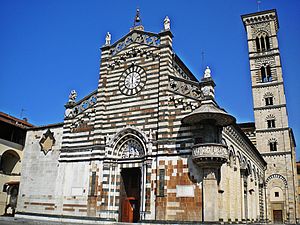 | ||
| Prato | ||
| region | Tuscany | |
|---|---|---|
| Residents | 193.325 (2018) | |
| height | 65 m | |
| Tourist info web | www.comune.prato.it | |
| no tourist info on Wikidata: | ||
| location | ||
| ||
Prato is a Italian Provincial capital of the province of the same name in the Tuscany.
background
This place was already settled by the Etruscans and Romans. The present city was first mentioned in a document in the 10th century. In the Middle Ages, the city became a trading and processing center for wool. This textile industry still exists today. Today it is no longer limited to wool, but includes the entire spectrum of textile production and processing. Here in Prato, clothes are still recycled on a large scale, which has earned the city the nickname "the rag center of Europe".
Nevertheless, the city is worth a visit, especially because of the old town and of course because you can get one or two bargains on clothing here.
The following districts belong to the municipality of Prato; Borgonuovo, Cafaggio, Canneto, Capezzana, Casale, Castelnuovo, Chiesanuova, Coiano, Figline di Prato, Filettole, Fontanelle, Galcetello, Galceti, Galciana, Gonfienti, Grignano, I Ciliani, I Lecci, Il Cantiere, Il Guado, Il Soccorso, Iolo , La Castellina, La Conca, La Dogaia, La Macine, La Pietà, La Querce, Le Badie, Le Caserane, Le Fonti, Le Fornaci, Maliseti, Mazzone, Mezzana, Narnali, Paperino, Pizzidimonte, Reggiana, San Giorgio a Colonica, San Giusto, San Paolo, Santa Cristina a Pimonte, Santa Lucia, Santa Maria a Colonica, Sant'Andrea, Sant'Ippolito, Tavola, Tobbiana, Viaccia and Vergaio.
getting there
By plane
By train
In the street
By boat
mobility
&groups=Maske,Track,Aktivitaet,Anderes,Anreise,Ausgehen,Aussicht,Besiedelt,Fehler,Gebiet,Kaufen,Kueche,Sehenswert,Unterkunft,aquamarinblau,cosmos,gold,hellgruen,orange,pflaumenblau,rot,silber,violett)
Tourist Attractions
Churches
- Cathedral of St. Stephen (Duomo di Prato, Duomo Santo Stefano). It is assumed that the church already existed in the 5th century, it is certain that parts go back to the 10th century. Since then, it has only been rebuilt and never rebuilt as a whole. The cathedral was built from a pieve that was enlarged in the 12th century. The cloister, rebuilt in the 15th century, was also completed in the 12th century. The construction of the bell tower began in the 13th century and was completed around 1356/57. It was built according to a design by Giudetto da Como. The current facade was completed in 1386 and is the work of Lorenzo di Filippo. Donatello's pulpit should be mentioned as a special feature of the outer facade. On the feast day the people are shown the Sacra Cintola (Belt of Our Lady), which also explains the location at the accessible corner.
- Santa Maria delle Carceri
- Santa Maria del Giglio
- Santa Maria della Pietà
- Santa Maria del Soccorso
- Santa Cristina a Pimonte
- Sant'Agostino
- San Domenico
- San Francesco
- San Fabiano
- San Niccolò
- Spirito Santo
- Santi Caterina de 'Ricci e Vincenzo Ferrer
Castles
- The Imperial fort (Castello dell'Imperatore) is a massive Stauffer fortress. On behalf of Fridrich II, it was built between 1237 and 1248.
Buildings
- Palazzo Pretorio
- Palazzo Comunale
- Palazzo Datini
- Collegio Cicognini
- Palazzo Vai
- Palazzo Banci Buonamici
- Palazzo degli Alberti
- Villa Il Palco
Museums
- Museo Civico, in the Palazzo Pretorio. Currently closed for renovation.
- 1 Center "L. Pecci", Viale della Repubblica 277. Tel.: 39 0574 53 17, Fax: 39 0574 53 19 01, Email: [email protected].
- Galleria degli Alberti
- 2 Museo del Centro di Scienze Naturali, Via Galceti 74. Tel.: 39 0574 46 05 03, Fax: 39 0574 174 12 02, Email: [email protected].
- 3 Museo della Deportazione, Via di Cantagallo 250. Tel.: 39 0574 47 07 28, 39 0574 46 16 55, Fax: 39 0574 46 16 65, Email: [email protected]. Closed: Tue.
- Museo / Laboratorio di Terrigoli
- Museo di Luicciana
- Museo dell'Opera del Duomo
- 4 Museo di Scienze Planetarie, Via Galcianese 20 / H. Tel.: 39 0574 447 71, 39 0574 44 77 77, Fax: 39 0574 44 77 25, Email: [email protected].
- Museo del Tessuto
- Museo della Vite e del Vino
- Palazzo Comunale
- Parco Museo Quinto Martini
- Outside the city in the municipality
- Museo Archeologico. Viale Papa Giovanni XXIII (c / o Villa Medicea "La Ferdinanda" di Artimino) in Carmignano.
- Museo della Badia. Piazza Agnolo Firenzuola 1, in Vaiano.
Streets, squares, bridges
- Stone arch bridge, over the river Bisenzio.
activities
shop
kitchen
nightlife
accommodation
health
Practical advice
trips
literature
Web links
http://www.comune.prato.it/ - Official website of Prato




